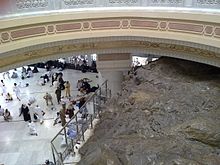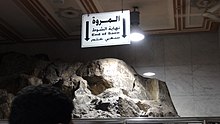as-Safā and al-Marwa
Coordinates: 21 ° 25 ' N , 39 ° 50' E

As-Safā and al-Marwa ( Arabic الصفا والمروة, DMG as-wa SAFA-l-Marwah ) are two hills in the Holy Mosque of Mecca , between which Muslims during the Islamic Haddsch- or umra -Wallfahrt seven reciprocate. This ritual after the Tawaf around the Kaaba takes place, is called in Arabic Sa'y ( "ropes, running, pursuit"), but sometimes even as tawaf called. The stretch between as-Safā and al-Marwa is called Masʿā ("place of hurrying").
history
In pre-Islamic times, the two stone idols Isāf and Nāʾila were worshiped in Safa and Marwa for a time . According to Arab tradition, it is a couple of pilgrims who came to Mecca, where they had fornicated in the Kaaba and were therefore petrified. The Quraishite Qusaiy ibn Kilāb had already brought the two stones to the place of Zamzam near the Kaaba in pre-Islamic times so that sacrifices could be made there.
When Mohammed made his first pilgrimage ( ʿUmra ) to Mecca, the so-called ʿumrat al-qadīya , (also: ʿumrat al-qaḍāʾ ), before the conquest of Mecca in 629, he himself carried out the run between Safā and Marwa. According to the detailed report from Muhammad ibn Saʿd , the Prophet set up his sacrificial animals at al-Marwa, had his hair there shaved by Ḫirāš ibn Umayya and said: “This is the place of sacrifice ( manḥar ), and all the gorges of Mecca are place of sacrifice. Then he slaughtered at al-Marwa ( fa-naḥara ʿinda l-Marwa ) "
Sura 2 ( al-Baqara ), verse 158, refers to the concerns of Muslims about continuing the traditional course between the two hills as part of the Islamic pilgrimage ritual, which gives permission for this ritual to continue. It says here:
“As-Safā and al-Marwa are among the cult symbols of God. If one goes on the (great) pilgrimage to the house (the Ka'ba) or the visiting tour (ʿUmra), it is not a sin for him to make company with them. "
The concerns of the Muslims handed down by the Koran exegetes and traditionalists against the further exercise of the generally practiced pre-Islamic custom of running or circulating on the two hills has thus been dispelled by the above verse from the Koran. Mohammed also affirmed this pre-Islamic custom through his own words as part of the pilgrimage ceremonies, as Sunnah : "God does not consider your pilgrimage or your little pilgrimage ʿUmra to be complete as long as you do not run the course between the two (hills)."
According to a hadith, which is attributed to the companion of the Prophet Jabir ibn ʿAbdallāh (st. 697), Mohammed performed the Saʿy on his riding camel on the farewell pilgrimage so that the people could see him. Both he and his companions are said to have performed the ritual only once on this occasion.
Islamic lore
During the Islamic period, the ritual course between the two hills as-Safā and al-Marwa received a new founding legend that relates it to Hagar , the maid of Abraham and mother of Ishmael . According to the Islamic tradition, Abraham received orders from God to leave Hagar and her little son alone with only the bare essentials in the desert between as-Safā and al-Marwa to test his faith. When they ran out of provisions, Hagar went in search of help and water. To make it easier and faster, she left her son Ishmael on the floor.
First she climbed the closer mountain, as-Safā, to look out there. When she found nothing there, she ran to the other mountain, al-Marwa, and looked there. When she was on one of the mountains she could see Ishmael and knew he was fine, but not when she was in the valley between the mountains. So she ran fast when she was in the valley and as she climbed up she ran at a normal pace. So she walked the same path seven times in the sweltering heat before returning to her son. When she got there, she found that where her screaming child kicked the sand with his foot, there was a spring. This spring is known today as the Zamzam Spring and, according to tradition, was brought up by God's angels both as a source of water and as a reward for Hagar's patience. For this reason, it is recommended to Muslim pilgrims to perform this ritual of three and a half paces back and forth during the pilgrimage (on the 10th day).
literature
- Toufic Fahd: Le Panthéon de l'Arabie centrale à la veille de l'hégire. Paris 1968, pp. 103-107.
Web links
supporting documents
- ↑ Cf. al-Azraqī: Achbār Makka . Ed. Desert field 49f. Available online: http://archive.org/stream/diechronikender00wsgoog#page/n514/mode/2up
- ↑ See Uri Rubin: "The Ka'ba: aspects of its ritual functions and position in Pre-Isamic and early Islamic times." In: Jerusalem Studies in Arabic and Islam. 8 (1986), p. 126.
- ↑ Kitāb aṭ-ṭabaqāt al-kabīr . (Ed. Josef Horovitz. Brill, Leiden 1909), Volume 2/1. P. 88, 15-18; Summary in German: S. XXXII; al-Wāqidī: Kitāb al-maġāzī. (Ed. Marsden Jones. London 1966), Volume 2, p. 737
- ↑ See Theodor Nöldeke : History of the Koran . Leipzig 1909. Bd. IS 177–178 with its reference to the Hadith literature
- ↑ al-Bukhari: Sahih, K. al-Ḥaǧǧ, 79; K. al-'Umra 10; in Ibn Hajar al-ʿAsqalānī : Fath al-bari , vol. 3. pp. 498–502; P. 614–615 (with commentary)
- ↑ Cf. Ibn Hazm : Ḥiǧǧat al-wadāʿ . Ed. ʿAbd-al-Ḥaqq Ibn-Mulāḥiqī al-Turkmānī. Beirut 2008. pp. 222f.
- ^ Tilman Nagel : Mohammed. Life and legend. Oldenbourg, Munich 2008, ISBN 978-3-486-58534-6 , p. 949.
- ↑ Müller, Anna: Comparison of the pilgrimages in Islam with the pilgrimages of the Catholic Christians , Munich: GRIN Verlag GmbH, 2009, ISBN 978-3-640-33141-3 , p. 5


